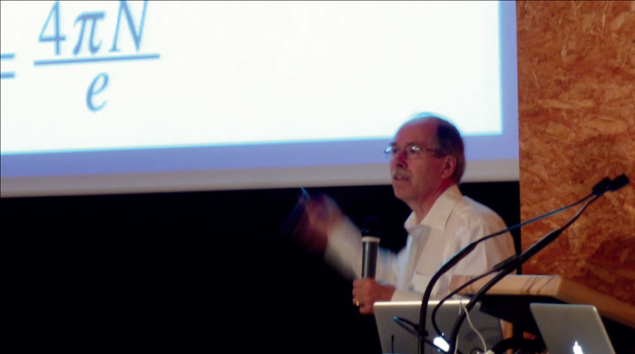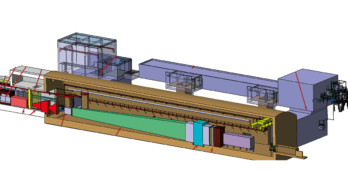
Image credit: R Soluk, University of Alberta.
MoEDAL, the “magnificent seventh” LHC experiment, held its first Physics Workshop in CERN’s Globe of Science and Innovation on 20 June. This youngest LHC experiment is designed to search for the appearance of new physics signified by highly ionizing particles such as magnetic monopoles and massive long-lived electrically charged particles from a number of theoretical scenarios.
Philippe Bloch of CERN commenced the meeting, stressing CERN’s support for the MoEDAL programme. He spoke of the key role that smaller, well motivated “high-risk” experiments such as MoEDAL play in expanding the physics reach of the LHC and reminded the audience that “one cannot predict with certainty where the next discovery will be made”.
Nobel laureate Gerard ’t Hooft began the morning’s theory talks with a reprise of his work on the monopole in grand unified theories (GUTs), elegantly showing how the beautiful monopole mathematics plays an important role in QCD and other fundamental theories. Arttu Rajantie of Imperial College London deftly recounted the story of “Monopoles from the Cosmos and the LHC”, concentrating on more recent theoretical scenarios, such as that of the electroweak “Cho-Maison” monopole, which are detectable at the LHC because they involve particles that are much lighter than the GUT monopole, with masses in the range 1 TeV/c2.
John Ellis and Nikolaos Mavromatos of King’s College London then changed the emphasis from magnetic to electric charge. Ellis described supersymmetry (SUSY) scenarios with massive stable particles (MSPs), such as sleptons, stops, gluinos and R-hadrons, which should be observable by MoEDAL. Mavromatos characterized the numerous non-SUSY scenarios that could give rise to MSPs, such as D-particles, Q-balls, quirks, doubly charged Higgs etc., all of which MoEDAL could detect.
In the afternoon, Albert de Roeck of CERN and Philippe Mermod of the University of Geneva laid out the significant progress made by CMS and ATLAS, respectively, in the quest for new physics revealed by highly ionizing particles. James Pinfold, of the University of Alberta and MoEDAL spokesperson, made the physics case for MoEDAL. He pointed out how its often-superior sensitivity to monopoles and massive slowly moving charged particles expanded the physics reach of the LHC in a complementary way. The MoEDAL collaboration, with 18 institutes from 10 countries, is still a “David” compared with the LHC “Goliaths” but its potential physics impact is second to none.
No workshop dealing with magnetic monopoles would be complete without an account of the search for cosmic monopoles. The two main experiments in this arena – MACRO, installed underground at the Gran Sasso National Laboratory in Italy, and the SLIM experiment, at the high-altitude Mount Chacaltaya Laboratory in Bolivia – were presented by Zouleikha Sahnoun of the SLIM collaboration. These two experiments still have the world’s best limits for GUT and intermediate-mass monopoles. Returning to Earth, David Milstead of Stockholm University described a project to search for trapped monopoles at the LHC. Importantly, this initiative is complementary to that of both MoEDAL and the main LHC experiments.
Why has the monopole not been seen in previous searches at accelerators? Vincete Vento of the University of Valencia offered an ingenious explanation. Monopoles are hiding in monopolium, a bound state of a monopole and an antimonopole, a suggestion that Paul Dirac made in his 1931 paper. Vento went on to describe a couple of ways that MoEDAL might detect monopolium.
In the last talk of the workshop, John Swain of Northeastern University presented the remarkable speculation that at the LHC the neutral Higgs boson could predominantly decay into a nucleus–antinucleus pair. He sketched, and nimbly defended, a theoretical justification for this surprising suggestion. Certainly, such a decay mode would be easily detectable by MoEDAL.
The clear message of the workshop is that MoEDAL has a potentially revolutionary physics programme aimed exclusively at the search for new physics, with the minimum of theoretical prejudices and the maximum exploitation of experimental search techniques. After all, in the words of J B S Haldane: “… the universe is not only queerer than we suppose, but queerer than we can suppose.”





